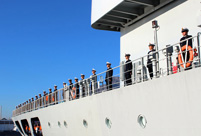 High speed train attendants receive training in Chongqing
High speed train attendants receive training in Chongqing
 Rare rainbow clouds seen in Fujian
Rare rainbow clouds seen in Fujian
 Small bracelet going global
Small bracelet going global
 Aerial Photography: Amazing Tianshan Mountains
Aerial Photography: Amazing Tianshan Mountains
 'Animals' in 2014 World Cup
'Animals' in 2014 World Cup
 Not afraid of death
Not afraid of death
 Chen Guangbiao ads on A15 of NYT to host charity luncheon for 1,000 poor and destitute Americans
Chen Guangbiao ads on A15 of NYT to host charity luncheon for 1,000 poor and destitute Americans
 Passionate bar babies and fans feel the charm of World Cup 2014
Passionate bar babies and fans feel the charm of World Cup 2014
 US aircraft carrier docks in HK, welcomes PLA aboard
US aircraft carrier docks in HK, welcomes PLA aboard
 Graduation season: 'Take graduation photos to mark our love'
Graduation season: 'Take graduation photos to mark our love'
QINGDAO, Shandong Province, June 26 -- A new zone designated in east China's Shandong Province to steer the country's marine development has rosy prospects, insiders have said.
The Qingdao West Coast New Area (QWCNA) aims to pilot innovation in marine technology and serve as a strategic base for deep sea and off-shore exploration. Its establishment in Huangdao District of the coastal Qingdao was approved by China's State Council, the cabinet, earlier this month.
Zhao Yingmin, head of the bureau of science and technology in Huangdao, said that the advanced technology owned by the area will be a trump card.
"We will work with science institutions to create unmanned submersibles to meet pressing demand for deep-sea and off-shore exploration," Zhao told Xinhua.
He said that the QWCNA is home to a variety of key scientific projects that will give the area technological firepower in its mission.
For instance, the new area has attracted the research base of China's most sophisticated research vessel, Kexue, or "Science." The ship can dock in the base and be repaired, and experiments can be conducted there.
Meanwhile, state-owned enterprise the China Ship Building Industry Corporation has delivered the first home-grown electronic propulsion system for ships along Qingdao's coast, and is building a facility to research, produce and experiment with advanced high-power engines, said the corporation's Feng Cheng.
These advantages aside, China is hampered by a number of disadvantages that make the QWCNA all the more necessary. It lacks ocean liners and ultralow-temperature stores, and has poor fishing equipment.
But the QWCNA has signaled its determination to make progress in this regard by pumping 10.17 billion yuan (1.63 billion U.S. dollars) into building a seafood trading center as well as an ultralow-temperature storage facility with a capacity of 400,000 tonnes.
In support of the area's future development, two major ports in the QWCNA will be transformed to offer international trade and financial settlement, according to Xue Qingping, director with the local development and reform commission.
"I believe that with avant-garde technology and the infrastructure building scheming that is taking place, the QWCNA will efficiently boost our country's marine development," Xue said.
Lying in the west coast of Jiaozhou Bay, the QWCNA covers 2,096 square km of land and about 5,000 square km of water.
 Silk Road, China's Grand Canal listed as World Heritage Sites
Silk Road, China's Grand Canal listed as World Heritage Sites Chinese 'Slumdog Millionaire'
Chinese 'Slumdog Millionaire' PKU students imitate famous paintings in real-person photos
PKU students imitate famous paintings in real-person photos Stewardesses in Brazilian soccer jerseys
Stewardesses in Brazilian soccer jerseys Puzhehei: land of idyllic beauty
Puzhehei: land of idyllic beauty Chinese navy fleet visits Cape Town, South Africa
Chinese navy fleet visits Cape Town, South Africa PLA naval cadets toss their hats at graduation ceremony
PLA naval cadets toss their hats at graduation ceremony Graduation photo ideas: reliable alumnus and happy alumna
Graduation photo ideas: reliable alumnus and happy alumna Super daddies in 2014 World Cup
Super daddies in 2014 World Cup Islands in S. China Sea better shown on new vertical atlas of China
Islands in S. China Sea better shown on new vertical atlas of China Girl takes father’s portrait to travel the world
Girl takes father’s portrait to travel the world Images of Xi'an: Part one
Images of Xi'an: Part one In Pictures: Female fans of World Cup
In Pictures: Female fans of World Cup Top 20 hottest women in the world in 2014
Top 20 hottest women in the world in 2014  China's top 10 representative architectures
China's top 10 representative architecturesDay|Week|Month